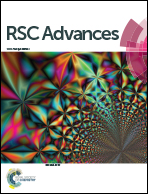Mechanistic study of N–H- and H–N-codoping of a TiO2 photocatalyst for efficient degradation of benzene under visible light†
Abstract
Non-metal codoping including nitrogen (N) and hydrogen (H) codoping has been emerging as an effective way to improve the performance of anatase TiO2 in solar cell, fuel conversion and pollutant degradation. However, the mechanism of the synergistic effect of N doping and H doping on TiO2 is still far from thorough. In this paper, N and H codoped TiO2 nanoparticles are obtained by N doping in ammonia and then H doping in hydrogen gas, which achieves substantially boosted efficiency and reaction rate in the photocatalytic degradation of benzene under visible light excitation. The superiority of the N–H–TiO2 photocatalyst was fully elaborated by comparing with H–N–TiO2, which was obtained by thermal treating in H2 and then NH3. The reaction rate of N–H–TiO2 in the photocatalytic degradation of benzene was nearly 2 times that of H–N–TiO2, ∼7 times higher than that of pristine TiO2. Furthermore, the cycling test revealed the high repeatability and stability of the N–H–TiO2 photocatalyst. The excellent performance N–H–TiO2 was attributed to an adequate concentration of NiHi defects occupying interstitial sites of the TiO2 structure and a disordered surface layer introduced by annealing in NH3 and H2 successively. The synergistic effect of N–H-codoping also increased the separation and migration of electron–hole pairs triggering a photoinduced redox reaction on the surface of TiO2.



 Please wait while we load your content...
Please wait while we load your content...